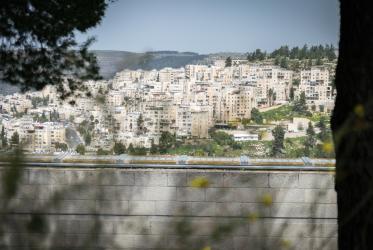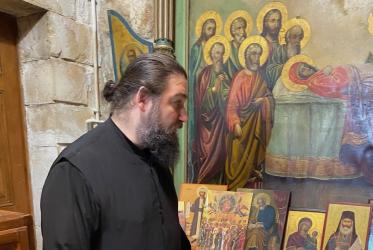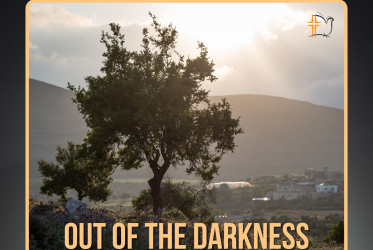Why was Jesus crucified? What implications does this have for the meaning of Jesus’s cross for us today? As Holy Week approaches, we seek to follow in the steps of Jesus as he makes his final journey from Jericho to Jerusalem—a journey which will result in his death a few days later.
The following series of reflections looks at several stopping points on this last journey of Jesus. We begin with his experience of Jericho, because it is the location where his initial profound and challenging choices will need to be made.
To grapple more deeply with the life and passion and death of Jesus, it is important to explore it in the context of the politics and history of the New Testament period. There are not, nor should there be, easy correlations between situations then and now. But the passion cannot be understood apart from politics. Jesus lived his life in a milieu in which his compatriots (and others) differed profoundly in their response to the political realities of his day. Support the rule of Rome? Collude with it for one’s own advantages? Oppose it, with armed force if necessary? Long for a Messiah, a “Son of David,” who will come and triumph over his people’s enemies? Seek to isolate oneself and hide away in safety? As we travel with Jesus on his journey, which we can truly say has changed the course of human history, we hear the echoes of these questions both in the biblical texts and in the landscape he encountered.
“Jerusalem is the place where God is crucified by passionately-held human desires and aspirations.”
Jerusalem has always been a city where religion and politics have collided, providing what is always a heady and sometimes toxic brew. That was so in biblical times, both in the Old Testament and New Testament periods, and it has often been the case in the centuries since. I first wrote the sentence in the epigraph above when I lived in Jerusalem several decades ago. It is as true now as it was then.
The word historical is not as simple as we often assume, but in “historical” terms I believe that Jesus’s actions in the temple after entering the city were what prompted the authorities to move against him, eventually resulting in his crucifixion. All four Gospels refer to what is generally called his cleansing of the temple (Matthew 21:12–17; Mark 11:15–19; Luke 19:45–46; John 2:13–22). One can imagine that, whatever his motivation, Jesus’s actions felt profoundly threatening to both the religious and the political authorities of the day. It was no accident that the main Roman barracks in Jerusalem, the Antonia, was located very close to the temple. This ensured that there would be easy access for troops who might be needed to put down any unrest or hostility to Roman rule that showed itself in the temple area. It is telling that in several of the Gospels one of the charges brought against Jesus at his trial was that he had threatened to destroy the temple (Matthew 26:61; Mark 14:58). One can easily see how his actions in the temple courtyard might have been interpreted in such a way.
Yet we can well expect that among the crowds, and perhaps among Jesus’s own disciples, the excitement generated by his initial actions in the temple had sparked considerable expectation. Those who resented—perhaps even struggled against—the Roman rulers and their local collaborators may well have seen what Jesus did as signalling his desire to lead them on a path towards liberation. The fact that he apparently made no further? move in that direction must have puzzled many and angered some. It has even been suggested that the reason for Judas Iscariot’s actions may have been to try and force Jesus’s hand into leading a fight for freedom. We cannot know for sure.
I believe that Gethsemane is the moment in time when those stark choices that, humanly speaking, confronted Jesus—to flee or to fight—agonizingly collided. The hour of prayer in the garden is the pivot on which history itself turns. To truly hold together within oneself such contrasts, such tensions, as Jesus did, and not opt for one “easier” solution was indeed an “agony.”
It led directly and imminently to his crucifixion.
The Bible offers us the challenge of holding together diversity and difference.[1] We want to celebrate God’s love for and involvement with creation, and God’s presence with us; yet at the same time we have to acknowledge an important biblical strand that speaks of God’s almost dangerous elusiveness. We learn in scripture that our position of being created in the image of God not only speaks of our privileged relationship with God; it also compels us to see something of God in one another. It is costly self-giving love, incarnated in Jesus Christ, that can and does draw together these deep contrasts which run through scripture, and which were also implicitly present in the conflicting ways of responding to the political realities of Jesus’s own day. Jesus’s love weaves them together and threads them all through the cross, that life-giving sign at the heart of our faith. I suggest, therefore, that there is a profound link between Jesus’s passion and crucifixion and the perhaps impossible tension involved in holding together the polarities that we have explored in the earlier reflections in this series. The events of Holy Thursday and Good Friday build to a climax in which such opposites are drawn tightly together, bound closely by bands of love.
I suspect that many of us focus on the cross through the spectacles offered by a particular vision, which can then draw other elements into itself. My own gaze takes place in the light of the great statement of Paul in 2 Corinthians 5:18–19: “God was in Christ reconciling the world to himself, . . . and entrusting the message of reconciliation to us.” The cross of Jesus demonstrates to us the necessary costliness of reconciliation; but it also suggests that reconciliation is at the very heart of the mystery of God.
Like many western Christians, it has taken me time to learn to love the Church of the Holy Sepulchre, the church holy in Christian tradition since at least the 4th Christian century as the place of Jesus’s crucifixion and tomb. When I first encountered it decades ago, I was shocked by the way that it was such a visible symbol of Christian disunity. In those days, some obviously needed repairs could not be made due to disagreements between the various Christian communities responsible for different parts of the building. It is a visible sign of hope and reconciliation that these restorations have now been completed.
Yet perhaps this still-divided building, within such a divided city, is an appropriate sacrament of the events it commemorates. It is a visible reminder why the cross happened, linked to the divisions and hostilities that are so much part of the human condition. It shows in stone the implications of our disunity. As the Church of the Holy Sepulchre, it suggests how costly to God is this wound; as the Church of the Resurrection—its preferred name among Eastern Christians—it is also a pledge of the possibility of resurrection.
By Dr Clare Amos, former programme coordinator for Interreligious Dialogue and Cooperation at the World Council of Churches
[1] For more details, see the Lent/Easter study from Churches Together in Britain and Ireland, “Opening the Scriptures: Setting Our Hearts on Fire,” 20 March 2020, https://ctbi.org.uk/.





